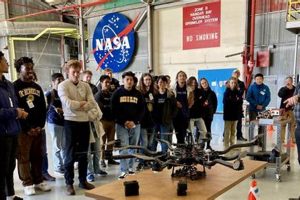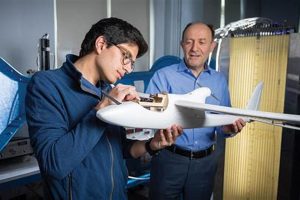The discipline incorporates a variety of mathematical techniques applied to the design, development, testing, and analysis of aircraft, spacecraft, and related systems. This field integrates principles from calculus, differential equations, linear algebra, numerical analysis, and statistics to solve complex problems specific to flight and space exploration. For example, trajectory optimization relies heavily on variational calculus, while computational fluid dynamics uses numerical methods to simulate airflow around airfoils and other aerodynamic surfaces.
Proficiency in quantitative reasoning is essential for addressing diverse challenges within the aerospace sector. Sound mathematical modeling enables engineers to predict performance characteristics, optimize designs for efficiency and safety, and analyze structural integrity under extreme conditions. Its historical roots lie in the need to understand and control flight, evolving alongside advancements in technology and computational power. It continues to drive innovation, allowing for more efficient, reliable, and groundbreaking designs.
Subsequent sections will delve into specific applications within structural analysis, propulsion systems, control theory, and orbital mechanics. These areas illustrate the pervasive role of sophisticated mathematical tools in contemporary aerospace applications. Each section will highlight relevant methodologies and their practical implications in the industry.
Guidance in Aerospace Engineering Applications
The following directives are offered to those seeking to master the quantitative facets of aerospace system design and analysis. Diligence in these areas will enhance both theoretical understanding and practical problem-solving capabilities.
Tip 1: Develop a Strong Foundation in Core Mathematical Principles: Proficiency in calculus, differential equations, linear algebra, and numerical methods is essential. Ensure a thorough comprehension of these fundamental topics before progressing to more specialized applications.
Tip 2: Emphasize Computational Skills: Familiarity with industry-standard software packages like MATLAB, Python (with libraries like NumPy and SciPy), and specialized CAD/CAE tools is crucial. Hands-on experience with these tools is as important as theoretical knowledge.
Tip 3: Focus on Model Development and Validation: Master the art of translating physical phenomena into mathematical models. Critically assess the assumptions and limitations of each model and validate its accuracy against experimental data or simulations.
Tip 4: Cultivate Problem-Solving Skills: Aerospace engineering challenges are often complex and multidisciplinary. Practice breaking down problems into manageable parts and applying appropriate analytical techniques to each component.
Tip 5: Explore Specialized Areas: Once a strong foundation is established, delve into specialized topics relevant to your area of interest. This may include astrodynamics, fluid dynamics, structural mechanics, or control systems. Each of these sub-disciplines relies on specific mathematical tools and techniques.
Tip 6: Seek Practical Experience: Internships, research projects, and participation in engineering competitions offer invaluable opportunities to apply theoretical knowledge to real-world problems. Such experiences also provide exposure to industry practices and professional networks.
Tip 7: Stay Current with Advancements: The field is constantly evolving. Remain informed about new mathematical techniques, computational tools, and emerging technologies through academic journals, conferences, and professional development opportunities.
These recommendations, when diligently followed, provide a solid pathway for success in a field demanding both theoretical rigor and practical application. Consistent effort and a dedication to continuous learning are paramount.
The subsequent and concluding section will provide a brief summary of the key aspects discussed.
1. Trajectory Optimization
Trajectory optimization constitutes a critical application of sophisticated quantitative methods within the field of aerospace engineering. It focuses on determining the most efficient or effective flight path for an aerospace vehicle, subject to a variety of constraints, employing mathematical techniques to minimize fuel consumption, flight time, or other performance metrics.
- Calculus of Variations and Optimal Control Theory
The foundation of trajectory optimization lies in the calculus of variations, which seeks to find functions that minimize or maximize functionals, and optimal control theory, which extends this to systems governed by differential equations. These mathematical frameworks provide the tools to formulate and solve problems where the goal is to find the control inputs (e.g., engine thrust, control surface deflections) that steer a vehicle along an optimal path. Real-world examples include minimizing the propellant required for a satellite to transfer from a low Earth orbit to a geostationary orbit, or determining the optimal ascent trajectory for a rocket launch vehicle.
- Numerical Optimization Algorithms
Due to the complexity of aerospace systems and the non-linear nature of the governing equations, analytical solutions to trajectory optimization problems are often unattainable. Therefore, numerical optimization algorithms are employed to approximate the optimal solution. These algorithms, such as sequential quadratic programming (SQP), genetic algorithms, and particle swarm optimization, iteratively refine the trajectory until a satisfactory solution is found. Applications include designing fuel-efficient routes for commercial airliners and planning the trajectories of interplanetary probes.
- Constraint Handling
Trajectory optimization problems are invariably subject to a range of constraints, including physical limitations of the vehicle (e.g., maximum thrust, angle of attack limits), environmental factors (e.g., atmospheric density, wind conditions), and mission requirements (e.g., arrival time, target location). Incorporating these constraints into the optimization problem requires advanced mathematical techniques, such as Lagrange multipliers and penalty functions. Examples include avoiding prohibited airspace for commercial aircraft, ensuring a spacecraft’s reentry trajectory remains within safe heating limits, and synchronizing rendezvous maneuvers with other spacecraft.
- Estimation and Uncertainty
The accuracy of trajectory optimization relies on the fidelity of the models used to represent the vehicle, the environment, and the control system. However, these models are always subject to uncertainties, such as errors in atmospheric density estimates or variations in engine performance. Robust optimization techniques, which explicitly account for these uncertainties, are employed to ensure that the optimized trajectory remains feasible and near-optimal even in the presence of disturbances. Applications include designing trajectories for autonomous vehicles operating in uncertain environments and planning robust launch trajectories that are insensitive to variations in weather conditions.
The above mathematical techniques and algorithms are interconnected and employed iteratively to achieve optimal trajectories. Their usage demonstrates the depth with which sophisticated analytical tools are integrated into aerospace engineering practice, proving its dependence on mathematical frameworks for efficient, robust, and innovative aerospace systems.
2. Structural Analysis
Structural analysis, a cornerstone of aerospace engineering, necessitates the application of sophisticated quantitative methods to ensure the integrity and reliability of aerospace vehicles. It forms a crucial interface between theoretical design and practical implementation, verifying that proposed structures can withstand anticipated loads and environmental conditions. This interface depends heavily on the correct and thorough integration of complex computations.
- Finite Element Analysis (FEA)
FEA is a numerical technique essential for predicting the behavior of complex aerospace structures under load. By discretizing the structure into smaller elements, FEA approximates solutions to partial differential equations governing stress, strain, and displacement. For example, FEA is used to analyze the stress distribution in an aircraft wing under aerodynamic loading, ensuring it can withstand the forces without failure. Its implications include optimizing material usage, identifying potential weak points, and validating designs before physical prototyping.
- Material Modeling
Accurate material models are vital for realistic structural analysis. These models describe the relationship between stress and strain for various aerospace materials, including metals, composites, and ceramics. For instance, understanding the anisotropic behavior of carbon fiber reinforced polymers is crucial for designing lightweight and strong aircraft structures. Proper material modeling enables engineers to predict material failure and optimize designs for maximum strength-to-weight ratio.
- Stability Analysis
Stability analysis assesses the susceptibility of aerospace structures to buckling or collapse under compressive loads. Techniques such as eigenvalue analysis are employed to determine the critical buckling loads and identify potential instability modes. For example, stability analysis is used to design the fuselage of a spacecraft to withstand the extreme compressive forces encountered during launch. Correct analysis ensures structural components maintain their shape and function even under significant stresses.
- Vibration Analysis
Vibration analysis investigates the dynamic response of aerospace structures to oscillatory forces. This includes determining natural frequencies, mode shapes, and forced response to external vibrations. For example, it is used to mitigate the effects of engine vibrations on aircraft wings or to isolate sensitive equipment from spacecraft vibrations. Correctly understanding and accounting for these vibrations prevents fatigue failure and ensures the reliability of critical components.
The foregoing facets demonstrate the inseparable connection between structural analysis and its reliance on sophisticated mathematics. The integration of FEA, accurate material models, stability evaluations, and vibration analyses allows engineers to predict the structural response of aerospace vehicles with precision, ultimately ensuring their safety and performance under diverse operational conditions.
3. Fluid Dynamics
Within aerospace engineering, fluid dynamics represents a crucial area where quantitative methods are applied to understand and predict the behavior of air and other fluids interacting with flight vehicles. The accuracy of aircraft and spacecraft design relies on the sound application of principles to simulate and optimize aerodynamic performance.
- Computational Fluid Dynamics (CFD)
CFD employs numerical methods to solve the governing equations of fluid motion, such as the Navier-Stokes equations. By discretizing the flow field into a mesh, CFD simulations can predict airflow patterns around aircraft wings, enabling engineers to optimize wing shapes for reduced drag and increased lift. This has a direct impact on fuel efficiency and overall aircraft performance; by integrating aerodynamic computations, design can be improved.
- Aerodynamic Modeling
Aerodynamic modeling involves developing mathematical representations of aerodynamic forces and moments acting on flight vehicles. These models are essential for flight simulation, control system design, and performance analysis. For instance, aerodynamic models are used to predict the stability and control characteristics of an aircraft, ensuring safe and predictable flight behavior. An appropriate aerodynamic representation is the foundation for flight control systems design.
- Boundary Layer Theory
Boundary layer theory describes the behavior of the thin layer of fluid adjacent to the surface of a flight vehicle. Understanding boundary layer phenomena, such as transition to turbulence and flow separation, is critical for predicting drag and heat transfer. For example, boundary layer theory is used to design cooling systems for hypersonic vehicles, preventing overheating and structural failure. It highlights an essential area in high-speed aerospace vehicle design.
- Wind Tunnel Testing
Wind tunnel testing is an experimental technique used to validate aerodynamic models and CFD simulations. By measuring forces and pressures on scale models of flight vehicles in a controlled environment, engineers can verify the accuracy of their computational predictions. Wind tunnel data is essential for calibrating CFD models and ensuring the reliability of aerodynamic designs. In effect, it bridges theoretical models with empirical verification.
These facets collectively illustrate how fluid dynamics underpins the analytical framework of aerospace engineering. By combining theoretical models, computational simulations, and experimental validation, engineers are able to design aerodynamic forms that push boundaries, offering novel approaches to the development of advanced aircraft and spacecraft.
4. Control Systems
Control systems are integral to aerospace engineering, relying heavily on advanced quantitative techniques for the design, analysis, and implementation of stable and effective automated regulation of flight vehicle behavior. Their efficacy hinges on sophisticated methods to maintain stability, execute maneuvers, and compensate for disturbances, forming a crucial bridge between theoretical design and operational performance. The absence of robust control can lead to catastrophic failures, underscoring their importance in ensuring safe and reliable flight.
Real-world examples underscore the practical significance of this interface. The automatic flight control system in commercial aircraft utilizes proportional-integral-derivative (PID) controllers and Kalman filters to maintain altitude, heading, and airspeed, thereby reducing pilot workload and improving fuel efficiency. The guidance, navigation, and control (GNC) systems of spacecraft employ optimal control theory and adaptive control algorithms to execute precise orbital maneuvers and maintain stable attitude, even in the presence of solar radiation pressure and other disturbances. Similarly, the active control systems in high-performance aircraft use state-space control techniques to enhance maneuverability and prevent structural damage during aggressive maneuvers, effectively expanding the aircraft’s flight envelope.
In summation, control systems in aerospace engineering are inextricably linked to complex quantitative methodologies. The application of techniques, ranging from classical control theory to advanced adaptive and optimal control, is fundamental to ensuring the stability, performance, and safety of air and space vehicles. Continued advancement in aerospace engineering necessitates ongoing development and refinement of these methods to address increasingly complex challenges and demanding performance requirements, pushing the boundaries of flight capabilities.
5. Orbital Mechanics
Orbital mechanics, a specialized domain within aerospace engineering, relies heavily on mathematics to model, predict, and control the motion of spacecraft and other objects in space. Its foundation lies in a synthesis of classical mechanics, celestial mechanics, and advanced computational techniques.
- Keplerian Orbital Elements
The Keplerian elementssemi-major axis, eccentricity, inclination, longitude of ascending node, argument of periapsis, and true anomalydescribe the size, shape, and orientation of an orbit. These elements are derived from Kepler’s laws of planetary motion, themselves mathematical statements about orbital behavior. For instance, determining the orbital elements of a newly launched satellite is critical for predicting its future position and planning subsequent maneuvers. Any deviations from planned elements must be corrected through controlled burns, calculated using numerical methods that rely on precise understanding of these parameters.
- Orbital Perturbations
Real-world orbits are subject to perturbations from gravitational influences of other celestial bodies, atmospheric drag, and solar radiation pressure. Mathematical models are required to accurately predict and compensate for these effects. For example, the long-term stability of satellite constellations in low Earth orbit is influenced by atmospheric drag and the Earth’s non-spherical gravitational field. Engineers use sophisticated numerical integration techniques to model these perturbations and design control strategies to maintain the desired orbital configuration.
- Orbital Maneuvers
Orbital maneuvers, such as Hohmann transfers and bi-elliptic transfers, are used to change a spacecraft’s orbit. These maneuvers are designed using mathematical optimization techniques to minimize propellant consumption. For instance, a Hohmann transfer is often used to move a satellite from a low Earth orbit to a geostationary orbit, requiring precise calculation of the required velocity changes and burn times. Any errors in these calculations can lead to significant deviations from the desired trajectory.
- Interplanetary Trajectory Design
Interplanetary trajectory design involves planning the flight path of spacecraft to other planets, often utilizing gravity assists to reduce propellant requirements. This requires solving complex trajectory optimization problems using numerical methods and celestial mechanics. For example, planning a mission to Mars involves calculating the launch window, trajectory, and arrival velocity to minimize travel time and propellant consumption. These calculations must account for the gravitational influence of the Sun, Earth, and Mars.
Orbital mechanics exemplifies the practical application of quantitative methods in aerospace engineering. The design and operation of spacecraft and satellites hinges on the ability to accurately model and predict orbital behavior, plan efficient maneuvers, and compensate for disturbances. Therefore, the intersection between orbital mechanics and the analytical tools within the aerospace field remains vital for advancing space exploration and utilization.
6. Numerical Simulation
Numerical simulation constitutes a critical application of computational techniques within aerospace engineering, relying heavily on mathematical formulations to approximate solutions to complex physical phenomena. This approach provides insights into the behavior of aerospace systems where analytical solutions are infeasible or impractical, playing a pivotal role in design optimization, performance prediction, and safety assessment.
- Computational Fluid Dynamics (CFD)
CFD employs numerical methods to solve the Navier-Stokes equations, enabling simulation of fluid flow around aircraft and spacecraft. This informs aerodynamic design, optimizing lift, drag, and stability. Examples include simulating airflow over a wing to minimize drag and improve fuel efficiency, or modeling shockwave formation around a hypersonic vehicle. The numerical solutions depend on discrete approximations and iterative algorithms that are mathematically intensive, forming a substantial part of aerospace computational practices.
- Finite Element Analysis (FEA)
FEA is a numerical technique used to analyze the structural behavior of aerospace components under various loads and environmental conditions. By discretizing a structure into elements, FEA can predict stress, strain, and displacement, thus informing structural design and material selection. Examples include analyzing the stress distribution in an aircraft fuselage to ensure structural integrity, or simulating the thermal expansion of a satellite component in orbit. Such analysis relies on the mathematics of partial differential equations and numerical solution techniques that are at the core of solid mechanics simulation in aerospace engineering.
- Multibody Dynamics Simulation
Multibody dynamics simulation is essential for analyzing the motion and interaction of multiple interconnected components in aerospace systems. This technique is used to model the deployment of solar panels on a spacecraft, predict the dynamic behavior of landing gear during touchdown, or simulate the operation of control surfaces on an aircraft. Mathematical formulations of rigid body dynamics, constraint equations, and numerical integration algorithms enable such simulations, offering insights into complex mechanisms critical to aerospace functions.
- Monte Carlo Simulation
Monte Carlo simulation utilizes random sampling to estimate the probability of different outcomes in complex aerospace systems. This technique is useful for uncertainty quantification, risk assessment, and reliability analysis. Examples include estimating the probability of a successful spacecraft mission given uncertainties in launch conditions or assessing the reliability of an aircraft engine component based on variations in manufacturing tolerances. This simulation method relies on statistical mathematics and numerical generation of random variables to represent real-world variability in a computationally tractable manner.
These facets underscore how numerical simulation serves as an indispensable tool in aerospace engineering by leveraging mathematical principles and computational algorithms to address complex challenges. These simulation techniques significantly enhance design processes, improve system reliability, and reduce the need for expensive physical prototypes, thus optimizing time and resources in the development of aerospace technologies.
7. Statistical Analysis
Statistical analysis constitutes a critical component within the broader framework. Its application ensures data-driven decision-making throughout the lifecycle of aerospace systems. This discipline employs mathematical techniques to quantify uncertainty, validate models, and assess the reliability of designs. The absence of statistical rigor can lead to inaccurate predictions, compromised safety margins, and increased costs. For example, in wind tunnel testing, statistical methods are used to analyze the variability in experimental data, providing confidence intervals for aerodynamic coefficients. This information directly impacts aircraft performance and stability assessments.
The significance of statistical analysis extends to several key areas. In manufacturing, statistical process control monitors the variability in component dimensions, ensuring adherence to design specifications and minimizing defects. Furthermore, reliability analysis employs statistical models to predict the probability of system failure, informing maintenance schedules and redundancy requirements. The design of experiments (DOE) utilizes statistical principles to efficiently explore the design space, optimizing performance characteristics while minimizing the number of simulations or physical tests. These applications illustrate that statistical analysis provides quantitative evidence for validating design decisions, assessing risk, and improving system performance.
In summary, statistical analysis serves as a crucial tool in aerospace engineering by enabling informed decisions based on quantifiable evidence. By addressing uncertainty, validating models, and assessing reliability, statistical methods contribute significantly to the safety, efficiency, and cost-effectiveness of aerospace systems. The integration of statistical thinking is essential for all practitioners within the aerospace sector.
Frequently Asked Questions
The following questions address common inquiries and concerns regarding the application within the aerospace field. The responses provided are intended to offer clarity and understanding of core principles and practical implications.
Question 1: Why is proficiency essential for aerospace engineers?
Mastery of is crucial because aerospace systems inherently involve complex physical phenomena described by mathematical models. These models are used for design, analysis, simulation, and control of aircraft, spacecraft, and related technologies. A solid foundation ensures accuracy, efficiency, and innovation in problem-solving.
Question 2: What specific mathematical disciplines are most relevant?
Relevant disciplines include calculus (single and multivariable), differential equations (ordinary and partial), linear algebra, numerical analysis, probability, and statistics. These provide the tools to model continuous and discrete systems, solve equations, analyze data, and quantify uncertainty.
Question 3: How is applied in structural analysis?
In structural analysis, techniques such as finite element analysis (FEA) are used to determine the stresses, strains, and deflections in aerospace structures under various loading conditions. These calculations rely on partial differential equations and numerical methods to approximate solutions for complex geometries and material properties.
Question 4: How is it applied in aerodynamics and fluid dynamics?
Computational fluid dynamics (CFD) utilizes numerical methods to solve the Navier-Stokes equations, which govern fluid flow. These simulations enable engineers to predict airflow patterns around aircraft and spacecraft, optimizing aerodynamic performance, and assessing stability.
Question 5: How is it applied in control systems design?
Control systems design relies on differential equations and transfer functions to model system dynamics, enabling the design of controllers that stabilize and regulate the behavior of aerospace vehicles. Techniques such as state-space analysis and optimal control theory are applied to meet performance requirements.
Question 6: What role does statistics play in aerospace engineering?
Statistics plays a vital role in uncertainty quantification, risk assessment, and reliability analysis. Statistical methods are used to analyze experimental data, validate models, and predict the probability of system failure. This helps engineers make informed decisions and improve system performance and safety.
The above considerations underscore that success in the aerospace sector depends on its sound incorporation in all facets of design, implementation, and testing.
The subsequent article segment will provide a curated compilation of further reading material for additional study.
Conclusion
This exploration has traversed the landscape of , emphasizing its foundational importance in aerospace engineering disciplines. Key aspects, including trajectory optimization, structural analysis, fluid dynamics, control systems, orbital mechanics, numerical simulation, and statistical analysis, have been presented, demonstrating their interconnectedness and individual significance to the field. These methodologies collectively enable the design, analysis, and verification of complex aerospace systems.
Continued advancement within the aerospace sector depends on the ongoing refinement and application of these quantitative tools. As aerospace systems become increasingly complex and performance demands escalate, proficiency in this area becomes paramount for addressing emerging challenges and pioneering innovative solutions. The future of aerospace engineering rests upon a commitment to rigor and ingenuity within the discipline.







